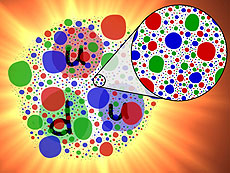Quarks and gluons and partons, oh my…
 |
| The proton consists of a complex mixture of quarks and gluons. Physicists use the word parton to describe all constituents of a proton.
|
When physicists talk about what is found inside a proton, they toss around many words. Quarks, gluons and partons are the most common ones. So what do they mean?
First we need to remember that a proton is a subatomic particle that can be visualized as a sphere about 10-15 meters across. That means they're as small compared to a virus as a virus is compared to you. When you consider that many viruses are so small that they can't be seen in the best microscope, you get a sense of just how small a proton is. The proton also has the same electric charge as an electron, but it is a positive charge rather than a negative one. We call the charge of a proton +1.
In the 1950s it became increasingly clear that the proton must consist of smaller particles. If the proton can be compared to a beanbag, the obvious question is: What do we know about the beans? In 1964, Murray Gell-Mann and George Zweig independently proposed that the proton (and also the neutron) consisted of three smaller particles. We now use Gell-Mann's name for them: quarks. While we now know of six types of quarks, the original theory only proposed three: up, down and strange. Quarks also have electrical charge, with the up quark having +2/3, while the down and strange quarks both have -1/3. Protons consist of two up quarks and a down quark, while neutrons consist of two down quarks and an up quark.
When quarks were proposed, they were still theoretical. They needed experimental confirmation. In 1968 at SLAC, experiments using electrons to probe the structure of the proton demonstrated clearly that protons contained within them smaller objects; the beans in the beanbag had been observed. However initially it was impossible to show that these proton constituents were quarks. Richard Feynman called them partons, as they were part of the proton.
Attempts to understand exactly that bound the partons inside the proton led to the generation of the current theory of strong force interactions, called quantum chromodynamics, or QCD. This theory postulated that there would be additional particles in the proton called gluons. In order to explain the measurements, these gluons would interact a different type of charge, called color, associated with the strong force. Gluons were observed at the HERA accelerator in Germany in 1979.
Subsequent experimentation has definitively shown that protons consist of both quarks and gluons. The term parton now means any particle inside a proton, neutron or other quark-containing particle. By far, quarks and gluons are the most common partons.
While up, down and strange quarks were components of the original model, we have since found three others, called charm, bottom and top. Both the bottom and top quarks were discovered at Fermilab. Studies at the Tevatron and now the LHC have searched for additional quarks, but these studies have thus far been unsuccessful.
Want a phrase defined? Have a question? Email Fermilab Today.
—Don Lincoln
|